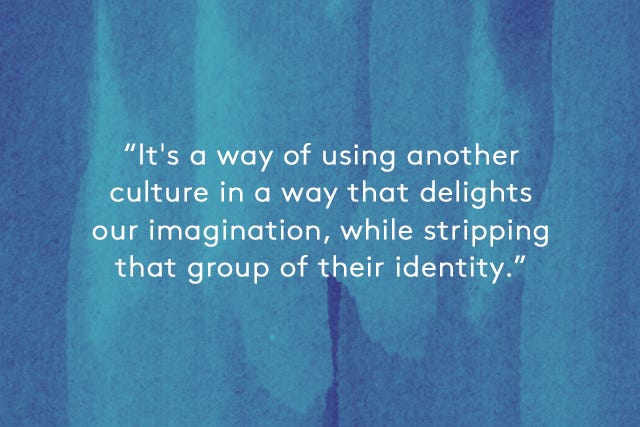Cultural Appropriation — Is It Ever Okay?

First, a definition.
Author Lenore Keeshig-Tobias defines cultural appropriation as “taking, from a culture that is not one's own, intellectual property, cultural expressions and artifacts, history and ways of knowledge.” But, as Adrienne Keene, PhD. of the blog Native Appropriations tells us, there is an additional factor at play: power. “There is always an inherent power imbalance — it is the dominant group taking from a marginalized group. With cultural appropriation, this also often plays out in the realities of colonization: It is the colonizer taking from the colonized.”

So, why is it problematic?
The harm done by cultural appropriation is often moral or symbolic in nature, so it can be tricky to pin down. But, there are some very concrete economic concerns. Dr. Keene points out that the so-called “tribal” prints and replicas of Native American designs that we see everywhere from Urban Outfitters to runway shows can be thought of as the intellectual property of the tribes and communities that invented them. If that’s the case, she says, “they should have the right to have power over [the designs], and to economically benefit from them.” Sound far-fetched? As she points out, “Christian Louboutin has a trademark on red soles, [which gives him] power over that design element and right of ownership. Why can't Native peoples ask for the same?”
In/visibility
It’s not just about money, though. The deeper harm in cultural appropriation lies in its tendency to replace real, live people with stereotypical symbols. Dr. Keene says: “I felt invisible as a Native person, because the only images my classmates and colleagues ever saw of Native people were the false stereotypes in fashion, advertising, and Hollywood. To them, even subconsciously, Indians were flat commodities to be bought and sold, whether as a fake dreamcatcher, beef jerky, or a mascot — not real, living, contemporary people.”

Everything But The Burden
Making the issue even trickier is the fact that cultural appropriation is often construed as an harmless, multicultural statement. As Dr. Houston states, "[appropriation] is harmful [because] it promotes a kind of enlightened racism. [It's] not as obvious as overt racial bigotry, but is probably more toxic, as it seems innocuous to dress up as Lil' Wayne for Halloween without recognizing the broader implications of this behavior."


Gray Area.
While everyone can (hopefully) agree that certain things are blatantly racist, there are a fair amount of gray-area appropriations, too. This writer, for example, wouldn’t dream of donning a war bonnet — but, I do own a pair of moccasins, and love dream catchers. I also grew up in the inner city and love hip-hop music, whose slang and style of dress has infiltrated my own to different degrees throughout the years. Can these be considered lesser aggressions, or are they still offensive?

So, how can we do better?
Now, all of this is not to say that you’re “not allowed” to wear what you want. What our experts consistently emphasized is doing your research first. “I, and others who care about cultural appropriation are not saying you can't ever wear items from another culture. What I argue for is doing it right. So, instead of going to [a mall store] and paying $7 for a cheap knock-off, go to the source. Know the story behind the piece, know the artist, what tribe they're from, why the specific designs were used. It puts the power back in the hands of the marginalized group.” Importantly, buying from a Native person or company also economically benefits the artist and the tribe, rather than a company that’s knocking off their designs.







